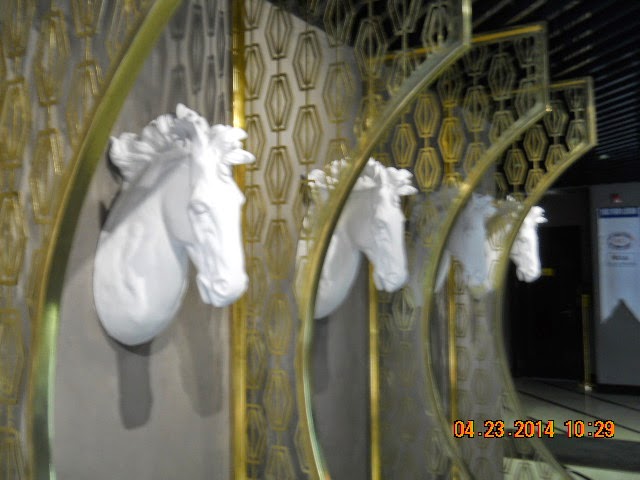Friday, April 25.
Hagia Sophia
Hippodrome. This was the venue for athletic contests built by 203 CE by Septimius Severus and renovated by Constantine in the early 4th century CE as part of the moving of the capitol from Rome to Constantinople.
Later, at the height of the Ottoman Empire (1609 - 16), the Blue Mosque was built to the South of the Hippodrome. The stones from the Hippodrome went into the Mosque; the dirt from the foundation was dumped where the Hippodrome was, raising the level several meters. Thus, there is a park in the shape of a hippodrome.
The three vertical items you see in the reconstruction above have survived, including the bronze serpents (decapitated) column and the Egyptian obelisk.
The obelisk went up here in the 4th century CE under Theodosius. (THe Egyptian date is mid -15th century BCE.) Made of a block of granite, it almost looks new. The marble base, however, is pretty eroded.
The Mozaik Museum is basically a structure built over a huge, but badly damaged Roman Palace mosaic floor. It probably dates back to the reign of Justinian, around 550 CE. This panel shows a couple of pudgy, unimpressed tourist kids taking the camel ride.
A lizard-eating chimera.
We had a terrific dinner at the Mozaik restaurant. Borek, lamb tagine, local cabernet & "Okuzgozu" (a local varietal the waiter said translates as "cows eyes").
****
4/26 Taksim to Modern Art Museum.
A gloomy day. So, of course, we chose to do a walk. This is Taksim Square, the main square in the newer part of Istanbul.
Attaturk was a military hero at Gallipoli. He became President, threw out British and Greek occupiers of Istanbul and the Mediterranean Coast, abolished the fez and head covering in public places, replaced the Arabic alphabet with Latin characters, and abolished all state religious institutions. Here's his memorial.
A water distribution facility, recently restored. It was staffed by two extremely nice young men, but they were not well informed. We were told that taksim means "distribution".
street scenes
Istiklal Caddesi, the main shopping street.
fish
There's a lot of jewelry.
lamps
British Consulate
One of our destinations was the Pera Museum, which was said to have a tile collection. Unfortunately, that part was closed, but we saw paintings by a 19th Century Turkish Diplomat, Osman Hamdi, including this one, of obscure inspiration, The Tortoise Trainer.
The museum also contained pictures and information about the work of European artists on the staff of European diplomats.
After stopping for mediocre boreks half way down a long steep hill and stepped street, we ended at the Modern Art Museum.
Building across from Modern Art Museum. We don't know what it is, but it's very nice.
Dinner at Samazen. Doner kabob. Yakut Ozkazgozu blend.
***
Sun. Apr 27
Topkapi Palace -- Long waits
Much of the tile work was beautiful. We were surprised to find rooms of relics; we did not know that was a Muslim practice. Many items were taken from Mecca when it was conquered under Selim the Grim in 1519: the rod of Moses, the cooking pot of Abraham, the tunic of Mohammed, the sword of David, many hairs of Muhammad's beard, the arm of John the Baptist, and so on.
Just outside the Topkaki is the former Orthodox Church of Hagia Eirene (Aya Irini), a Byzantine Church that was used mostly for storage after the Moslem conquest of Istanbul.
dinner at Kayikci: lamb medallions , sea bass in paper.
Monday, April 28
We started the day -- a very wet one -- at Sultanamet Mosque (Blue Mosque). It is very large and dramatic. Here's a sunny day picture. The use of six minarets (instead of four)was controversial; the architect, Sinan, had the strong backing of the Sultan. Note how the minarets on the right do not line up. Whether this is due to soil conditions or something else we have not been able to determine.
the dome is held up by four gigantic columns
The tile is amazing.
Bruce went on a long walk; Leslie took a rest.
The Grand Bazaar is 450 years old and has thousands of little shops.

This tower was built to watch for fires; now it is a landmark in the middle of a university.
The Suleymaniye Mosque is a few blocks further up. The architect -- Mimar Sinan -- was also the designer of the Blue Mosque.
This one is a bit smaller and has more windows to allow light to come in.
The walk continued through a sort of light industry area. There was a whole street of shops that dealt in belt buckles.
Someone's falcon.
My walk continued over the Galata Bridge and took in the fish market. But the camera batteries died.
***
Two notes on the hotel breakfast.
Honey is always available:
There is a corner with a sign "Children's Buffet":
The plate holds a variety of cookies. The bowl that looks like a fruit mix is candy. Other bowls are peanut butter and jelly.
Back to Matbeh for dinner. The hummus was quite different, very stiff and seasoned with cinnamon. Bruce chose the lamb medallions with lamb brains appetizer. To our surprise, this turned out tobe slices of sausage.
It looks like (but definitely is not) your grandmother's gefilte fish. Both are acquired tastes.
Main course a lam stew with apricots. And the wonderful baklava.
.JPG)
.JPG)
.JPG)
.JPG)



















.JPG)
.JPG)
.JPG)










.JPG)












